Introduction
Propolis (bee glue) is a sticky resinous substance produced by honey bees (Apis mellifera L.), which serves mainly as a building and defensive material. Honey bees use it to fill cracks, to cover the internal hive walls, to repair and seal the honeycomb cells, and to embalm the carcasses of invaders who penetrated and died inside their hives, thus removing the unpleasant odor and bacterial flora accompanying their decomposition.1-3
Propolis is a complex natural product with different color (green, red, yellow, and brown) that is collected and processed by honey bees from flower buds and exudates of many plant species. To produce propolis, bees transport the plant material to the hive and mix it with beeswax and saliva, thereby obtaining a highly adhesive substance. The chemical composition and biological properties of propolis can vary greatly depending on the plant source, season, climate, altitude, and other characteristics of the geographic region.4 In the last few decades, numerous studies described the rich chemical composition and biological activities of propolis. Among the major components are polyphenols (represented mainly by flavonoids), aromatic acids, aromatic esters, aliphatic acids, aliphatic esters, volatile compounds, aromatic compounds, hydrocarbons, steroids, enzymes, waxy acids, alcohols, aldehydes, ketones, amino acids, micronutrients and macronutrients, vitamins, essential oils, sugars, pollen, and other organic matter.5-7 These biologically active compounds determine the antioxidant, immunomodulatory, anti-inflammatory, antibacterial, antiviral, antifungal, antiparasitic, anticarcinogenic, hepatoprotective, anti-ulcerogenic, anti-allergic, antidiabetic, astringent, anaesthetic, and other therapeutic activities of propolis.1,5,8,9
In recent years, the biological properties of propolis as a natural product attracted research attention on its application in the field of food industry. The broad antimicrobial spectrum and antioxidant potential of propolis offer great possibilities and perspectives for its wide application as a food additive, as a functional food ingredient, as a mean for biopreservation prolonging the shelf-life or improving the food stability, quality and safety, especially in perishable and highly sensitive to microbial spoilage foods such as fruits, meat, fish, poultry and dairy products.7
Milk and dairy products are an excellent medium for microbial growth, thus may play role as a vector of spoilage microorganisms and foodborne pathogens. The pasteurization of raw milk before consumption or manufacture of dairy products is an important technological process, which significantly decreases the number of microorganisms, but does not provide a sterile product.10 Moreover, the survival of unwanted microflora in some dairy products such as kashkaval (a traditional hard cheese produced in Bulgaria and other Balkan countries), for the manufacture of which the raw milk undergoes only short heat treatment at 63-65°C, but not a pasteurization process11, is a major problem in the cheese industry, leading to subsequent microbial decay, deterioration of quality, loss of commercially acceptable appearance, economic losses, and creates a risk for food poisonings. A typical example in this regard is the fungal spoilage of hard, semi-hard, and semi-soft cheeses during the processes of ripening and storage.12 One of the traditional approaches for solving the problems associated with fungal decay in cheese industry (in particular in kashkaval production sector) is the application of coatings based on paraffin, polyvinyl acetate, plasticizers, antibiotics (natamycin), and other chemical substances to protect the cheese surface.13,14 However, the wide use of chemical preservatives and fungicides creates a risk for the consumer’s health, although most of them are allowed to be used in foods. Therefore, the application of some non-conventional methods with the use of natural and safe preservatives such as propolis could avoid or delay the fungal spoilage, reduce the risk for the consumers, and increase the nutritional value of the product.
Therefore, the aim of the present study was to evaluate the efficacy of edible films comprised of 1% carboxymethyl cellulose in combination with three types of 1% propolis ethanolic extracts on quality improvement and storage life extension of Bulgarian kashkaval cheese.
Materials and Methods
Culture Media
Peptone Water
PW is a broth medium used for stimulation of the growth of the microorganisms in the sample. The medium was prepared by the following prescription: 10 g peptone (Himedia®, India) and 5 g NaCl (Merck, Germany) were dissolved in 1 L of deionized water. The final pH was corrected to 7.2 ± 0.2, and then the medium was autoclaved at 121°C for 20 min.
LAPTg10 Agar
LAPTg10 is a selective medium for enumeration of lactic acid bacteria, prepared according to the manufacturer’s (Laboratorios Conda S.A., Spain) prescription: 45 g of LAPTg10-solid substance mixture (containing 15 g peptone, 10 g yeast extract, 10 g tryptone, and 10 g glucose) was dissolved in 1 L of deionized water. The final pH was adjusted to 6.6-6.8, and then 1 mL Tween 80 (Sigma-Aldrich, USA) and 15 g agar (Sigma-Aldrich®, USA) were added. The medium was autoclaved at 121°C for 20 min.
Chloramphenicol Glucose Agar (CGA)
CGA is a selective medium for enumeration of yeasts and fungi, prepared according to the manufacturer’s (Scharlab S.L., Spain) prescription: 40 g of the medium (containing 20 g dextrose, 5 g yeast extract, 0.1 g chloramphenicol, and 15 g agar) was dissolved in 1 L of deionized water. The final pH was adjusted to 6.6 ± 0.2, and then the medium was autoclaved at 121°C for 15 min.
Propolis
Fresh propolis samples were purchased from producers of bee products from three different regions in the Western part of Bulgaria – town of Simitli, Blagoevgrad district (41°53′N 23°7′E), town of Bankya, Sofia district (42°42′N 23°8′E) and village of Vladimir, Pernik district (42°26’N 23°5’E). The three propolis samples demonstrated different antimicrobial activity, total phenolic, and total flavonoids contents, and antioxidant activity.
Preparation of Propolis Extracts
A mass of 4 g of each propolis sample was finely chopped, placed in plastic tubes, macerated with 10 mL of 50% ethyl alcohol (Sigma-Aldrich, Merck, Germany), vigorously shaken on vortex (V-1 plus, Biosan, Latvia) for 15-20 s, and allowed to extract under refrigerated conditions (4°C) for 48 h. During the extraction, the samples were periodically vortexed. The obtained ethanolic extracts were filtered and then stored for further use.
Preparation of Gels for Edible Films
The 1% gels for edible films were prepared by dissolving 4 g carboxymethyl cellulose – CMC (Walocel CRT 50000 PA 07, Dow Wolff Cellulosics GmbH, Germany) in 400 ml of distilled water, mixed on a magnetic stirrer (Isolab, Germany) at 800 rpm for 30-40 min until completely dissolved, and then stored under refrigerated conditions (4°C) for 24 h to eliminate the air bubbles from the gels resulting from the stirring. Next, 10 mL of each propolis extract in 50% ethanol was added to the relevant CMC gel (400 ml) and stirred under identical conditions. Thus, three types of CMC gels with a final propolis extract concentration of 1% were prepared. The gels were designated as T1 (with propolis from Simitli), T2 (with propolis from Bankya), and T3 (with propolis from Vladimir), respectively.
Rheological Behavior and Physicochemical Properties of The Gels for Edible Films
The rheological characteristics of three gels (T1, T2, and T3) were determined using a rotational viscometer Premium-L (Fungilab S.A., Spain) at temperature of 23°C. The structural viscosity (η) was measured at different velocity gradients (D), ranging from 2.04 s-1 to 10.20 s-1. A TL6 spindle was used. Shear stress (τ), flow consistency index (k), flow behavior index (n), and correlation coefficient (R2) were determined.
The pH values were measured by a pH-meter (pH 7110, WTW, Germany) equipped with a glass electrode, which was immersed directly into the gels at room temperature (23°C).
Kashkaval Cheese
Blocks of ripened kashkaval cheese, weighing 1 kg (15 x 10 x 6 cm), manufactured in accordance with the Bulgarian State Standard BDS 14:201011, were kindly provided by a farm located in the region of Razlog, Blagoevgrad district, Bulgaria. Kashkaval cheese was made from fresh whole cow’s milk with titratable acidity of 16-18°T using a symbiotic starter culture of Lactobacillus bulgaricus, Streptococcus thermophilus, Lactobacillus helveticus, and Lactococcus lactis subsp. lactis, without addition of antibiotics, stabilizers, emulsifiers, chemical preservatives, and absence of paraffin coatings.
Application of Edible Films
The kashkaval cheese blocks were additionally cut into uniform pieces weighing 0.5 kg and divided into 4 experimental groups, each of them including 3 pieces: group I – covered with gel T1, group II – covered with gel T2, group III – covered with gel T3, and group IV – untreated cheese, served as a control (Fig. 1 A). The surfaces of cheese blocks (except the control group) were covered completely with the relevant gels (T1, T2, and T3) using brushes, and then allowed to dry. After complete drying of the first layer, a second one was applied to obtain quality and stable double-layer edible films (Fig. 1 B). The cheese blocks were placed into individual plastic boxes and stored at 4°C and at 75% RH for 56 days. During the storage period, all experiment groups were observed for fungal growth, and samples for physicochemical and microbiological analyses were taken once a week.
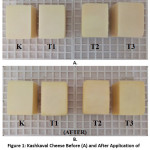 |
Figure 1: Kashkaval Cheese Before (A) and After Application of Edible Films of 1% CMC with Three Types of 1% Propolis Ethanolic Extracts (B) on Day 0 of the Storage. |
Physicochemical Analysis
Titratable Acidity
Determination of titratable acidity was implemented according to the Bulgarian State Standard BDS 1111:198015 by the titration method. Five grams of kashkaval cheese were weighed, mashed in a mortar, and mixed with 50 ml of 0.5% NaCl heated to 45°C. Then, a few drops of phenolphthalein (Sigma-Aldrich, Merck, Germany) as an indicator were added, and the titration was performed by 0.1 N NaOH (Sigma-Aldrich, Merck) until the appearance of a pale pink color persisting for over 1 min. The results were calculated as the mean value of three consecutive experiments and expressed as Torner degrees (°T).
Determination of pH
The pH values for each experimental group were measured by a pH-meter (pH 7110, WTW, Germany) equipped with a glass electrode, which was immersed into mashed and diluted with distilled water (1:1) kashkaval samples at room temperature (23°C).11
Microbiological Analysis
Five grams of each experimental group of kashkaval cheese were weighed, mashed in a sterile mortar, and mixed with 45 mL of peptone water, transferred into plastic bags, and then homogenized in masticator (IUL S.A., Spain) for 2 min at normal speed. Next, ten-fold serial dilutions of each sample in sterile 0.5% NaCl were prepared for pour plating. A volume of 1 mL of the appropriate dilution was transferred into Petri dishes and layered with preliminarily melted and tempered at 40-45°C LAPTg10 and CGA agar media.11
Enumeration of Characteristic Microorganisms
The colony-count technique for characteristic microorganisms (lactobacilli and lactic streptococci) in kashkaval cheese was implemented on LAPTg10-agar medium. The Petri plates were incubated at 37°C for 48 h. The obtained results were expressed as cfu/g cheese.11
Enumeration of Yeasts and/or Fungi
The colony-count technique for yeasts and/or fungi in kashkaval cheese was implemented according to the Bulgarian State Standard BDS ISO 6611:200616 on CGA medium. The Petri plates were incubated at 25°C for 48/72 h. The obtained results were expressed as cfu/g cheese.
Organoleptic Analysis
Organoleptic analysis was performed according the Bulgarian State Standard BDS 14:201011. For this purpose, 20 unbiased consumers over 18 years old, who consume kashkaval cheese on a regular basis, were invited. On the next day after the treatment with propolis extracts, the samples T1, T2, T3, and control (coded as T4 without the knowledge of the tasters) were cut into portions of 6-8 g and placed in disposable plastic plates. The cheeses were evaluated by comparison of 7 organoleptic parameters (taste, odor, aroma, texture, cutting surface, overall appearance and color) using the 9-points Hedonic scale: 1 = disliked extremely; 2 = disliked very much; 3 = disliked moderately; 4 = disliked slightly; 5 = neither liked nor disliked; 6 = liked slightly; 7 = liked moderately; 8 = liked very much; 9 = liked extremely. The results from the tasting were recorded on individual questionnaire cards, and then a sensory profile of each type of kashkaval cheese was made.
Statistical Analysis
Data from triplicate experiments were processed with MS Office Excel 2010 software, using statistical functions to determine the standard deviation (±SD), and maximum estimation error at significance level ά<0.05. Statistical evaluation was performed by one-way analysis of variance (ANOVA) using Statgraphics Centurion statistical program (v. XVI; StatPoint Technologies, Inc., Warrenton, VA, USA). Mean differences were established by Fisher’s least significant difference test for paired comparison at significance level α=0.05.
Results and Discussion
Rheological Behavior and Physicochemical Properties of The Gels for Edible Films
Viscosity is considered one of the main rheological properties of the gels, and it is essential for obtaining quality and stable edible films. The values of viscosity of the three gels of 1% CMC with three types of 1% propolis ethanolic extracts (T1, T2, and T3) at different velocity gradients (shear rates) are presented in Table 1. As seen from the results, with increasing the shear rate (D) the viscosity (η) decreased, which confirmed the non-Newtonian type of rheological behavior of the studied gels. The T1 gel showed the highest viscosity values, as for the different shear rates they were higher with 39% to 54% than those of T2 gel, and higher with 59% to 105% than those of T3 gel.
Table 1: Viscosity of 1% CMC Gels with Three Types of 1% Propolis Ethanolic Extracts (T1, T2 and T3) at Different Shear Rates.
| Velocity Gradient (s-1) |
Viscosity (mPa.s) |
||
| T1 | T2 | T3 | |
| 2.04 | 1514±4.24*a,A | 980±5.66a,B | 740±5.66a,C |
| 2.55 | 1421±2.83b,A | 939±4.24b,B | 724±5.66b,C |
| 3.40 | 1344±2.83c,A | 888±4.24c,B | 705±2.83c,C |
| 4.08 | 1274±2.83d,A | 842±2.83d,B | 691±2.83d,C |
| 5.10 | 1207±1.41e,A | 822±2.83e,B | 673±4.24e,C |
| 6.80 | 1098±1.41f,A | 770±2.83f,B | 645±1.41f,C |
| 8.50 | 1034±1.41g,A | 732±1.41g,B | 624±2.83g,C |
| 10.20 | 960±2.82h,A | 692±1.41h,B | 602±2.83h,C |
*±SD (standard deviation)
a-h Means in a column with different superscripts differ significantly (p<0.05).
A-C Means in a row with different superscripts differ significantly (p<0.05).
The rheological behavior of all gels was similar to that of the pseudoplastic fluids. The obtained rheograms (D/τ) represent curves convex to the shear stress (τ) axis, and when approximated, pass through the beginning of the coordinate system (Fig. 2). According to the graphic in logarithmic coordinates, the dependence of shear rate on shear stress is linear, and the variance of the viscosity of D can be described by the Ostwald-de Waele equation used for pseudoplastic fluids:17
η = k . Dn-1 (1)
where η is viscosity, k – flow consistency index (Рa.sn), D – shear rate (s-1), n – flow behaviour index.
The flow consistency index (k) is an expression of the viscosity – the higher k means higher viscosity. The flow behavior index (n) is an indication of how much the liquid differs from the Newtonian fluid (n = 1). For the pseudoplastic fluids, it takes lower values (n < 1) and the lower this value, the more pronounced the non-Newtonian character of the certain fluid.18 The values of the coefficients in equation (1) for the three types of gels are presented in Table 2. The relatively high values of the correlation coefficient (R2) indicate that equation (1) is suitable for calculating the viscosity of the studied gels, depending on the D values in the range of 2.04 to 10.20 s-1.
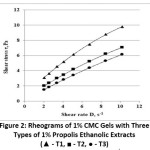 |
Figure 2: Rheograms of 1% CMC Gels with Three Types of 1% Propolis Ethanolic Extracts (▲ – T1, ■ – T2, ● – T3) |
Table 2: Flow Consistency Index, Flow Behavior Index, Correlation Coefficient, and pH of 1% CMC Gels with Three Types of 1% Propolis Ethanolic Extracts.
| Parameter | Gel/edible film | ||
| T1 | T2 | T3 | |
| k, Pa.sn | 1.86 | 1.14 | 0.82 |
| n | 0.72 | 0.79 | 0.87 |
| R2 | 0.999 | 0.999 | 0.999 |
| pH | 5.75 ± 0.03*b | 5.79 ± 0.03ab | 5.86 ± 0.01a |
k – flow consistency index; n – flow behavior index; R2 – correlation coefficient; *±SD (standard deviation)
a-b Means in a row with different superscripts differ significantly (p<0.05).
As seen from the results in Fig. 1, Table 1, and Table 2, the type of propolis affected the rheological characteristics of studied gels for the preparation of edible films. T1 gel showed the highest flow consistency index (k), which was greater with 63% and 127%, compared with T2 and T3 gels, respectively. The non-Newtonian behavior of T1 gel was also the most pronounced – it had the lowest flow behavior index (n). In addition, pH of the gels varied in close ranges, with the highest pH value of gel T3. Although prepared in the same way and with the same concentration of CMC and propolis (1%), the difference in rheological characteristics of the gels could be explained with the different origin and chemical composition of propolis samples, as well as the probable interactions between the propolis compounds and CMC.
Еffects of Edible Films on The Physicochemical Parameters of Kashkaval Cheese
The results presented in Table 3 show that titratable acidity and lactic acid concentration in all experiment groups declined gradually, and this trend was observed until the end of observation period (56th day). During the first two weeks of the storage, the application of edible films with 1% propolis ethanolic extracts (T1, T2 оr T3) maintained higher levels of titratable acidity and lactic acid in comparison to the control sample. During the first half of the storage, a significant increase in pH values in all treatments (T1, T2, T3, and control) was recorded, reaching the highest value of 6.10 (on 28th day), after that they returned to the initial levels of 5.63-5.79 and remained almost unchanged during the second half of the storage period. The results could be explained with the continuing process of late-ripening and proteolysis, leading to the formation of small polypeptides, free amino acids, and other low molecular weight compounds easily digestible by the human organism.19 The second reason for the physicochemical changes described above was associated with the gradual decrease of the number of lactic acid bacteria and lactic acid production respectively, normally observed by the end of the ripening period of dairy products (Table 4).
The physicochemical changes during of ripening stage and proteolysis in hard cheeses can be significantly influenced by different factors such as origin and composition of milk, composition of starter culture, presence of undesirable microflora, storage conditions, aging time, application of antimicrobial agents, etc. In contrast to our results obtained for ripened cheese, the existing reports in the literature consider the use of propolis in freshly prepared cheeses, marking the general trend – an increase in titratable acidity and a decrease in the pH values, characteristic for the maturation process. Metwalli20 found a gradual increase in titratable acidity of Egyptian kareish cheese made from buffalo’s milk treated with 5% and 10% aqueous propolis extract, which average values remained close to the control sample during the entire storage at 4°C for 30 days. Similar data have been reported by El-Deeb and Omar21 who observed a gradual increase in titratable acidity and decrease in pH values in kareish cheese treated with two concentrations (6 and 10%) of propolis extracts (ethanolic and aqueous) during the storage at 5°C for 28 days. The authors also found that propolis treatment increased the phenolic compounds, flavonoids, and antioxidant activity of kareish cheese, thus improved its quality, sensory acceptability, and nutritional value. The application of a hydroalcoholic extract of propolis as a biopreservative in Italian Fior di Latte semi-soft brined cheese, produced from cow’s milk, did not affect significantly the pH values (ranging between 5.8 and 5.4) during the entire observation period at 10°C for 6 days.22 The effects of propolis on cheese shelf-life were studied also by Saleh and Khalil23 who stated that the addition of 5% and 10% ethanolic propolis extracts in Egyptian Domiati cheese, increased the titratable acidity in both treatments in the beginning of the experiment, compared to the control, followed by gradual increase in all samples during the storage for 60 days. The pH values decreased from 6.2 to 5.4 in control, and from 6.1 to 5.6 in propolis treated cheese until the end of the storage at 4°C. These physicochemical changes in Domiati cheese were much more significant during storage at room temperature.
Table 3: Effects of 1% CMC Edible Films with Three Types of 1% Propolis Ethanolic Extracts on Physicochemical Parameters of Kashkaval Cheese.
| Day | Sample | Тitratable Acidity °Т |
Lactic Acid g |
pH |
| 0 | К | 217.8 ± 0.28*b | 1.960 ± 0.003b | 5.70 ± 0.03b |
| Т1 | 216.0 ± 0.28c | 1.944 ± 0.003c | 5.79 ± 0.03a | |
| Т2 | 219.8 ± 0.57a | 1.978 ± 0.005a | 5.74 ± 0.01ab | |
| Т3 | 213.2 ± 0.28d | 1.919 ± 0.003d | 5.70 ± 0.03b | |
| 7 | К | 212.6 ± 0.57c | 1.913 ± 0.005c | 6.10 ± 0.03a |
| Т1 | 215.2 ± 0.14b | 1.937 ± 0.001b | 6.09 ± 0.00a | |
| Т2 | 216.0 ± 0.28b | 1.944 ± 0.003b | 6.07 ± 0.01a | |
| Т3 | 217.8 ± 0.28a | 1.960 ± 0.003a | 6.01 ± 0.03b | |
| 14 | К | 206.0 ± 0.57b | 1.854 ± 0.005b | 6.08 ± 0.03a |
| Т1 | 207.0 ± 0.57b | 1.863 ± 0.005b | 6.08 ± 0.00a | |
| Т2 | 209.0 ± 0.28a | 1.881 ± 0.003a | 6.08 ± 0.03a | |
| Т3 | 208.4 ± 0.28a | 1.876 ± 0.003a | 6.00 ± 0.00b | |
| 21 | К | 207.6 ± 0.85ab | 1.868 ± 0.008ab | 6.10 ± 0.03a |
| Т1 | 206.4 ± 0.28b | 1.858 ± 0.003b | 6.10 ± 0.03a | |
| Т2 | 208.0 ± 0.28a | 1.872 ± 0.003a | 6.10 ± 0.03a | |
| Т3 | 207.4 ± 0.57ab | 1.867 ± 0.005ab | 6.07 ± 0.01a | |
| 28 | К | 201.4 ± 0.57bc | 1.813 ± 0.005bc | 6.10 ± 0.03a |
| Т1 | 202.6 ± 0.85ab | 1.823 ± 0.008ab | 6.10 ± 0.03a | |
| Т2 | 201.0 ± 0.28c | 1.809 ± 0.003c | 6.00 ± 0.00b | |
| Т3 | 203.0 ± 0.28a | 1.827 ± 0.003a | 6.00 ± 0.00b | |
| 35 | К | 200.6 ± 0.28b | 1.805 ± 0.003b | 5.73 ± 0.01a |
| Т1 | 201.2 ± 0.28ab | 1.811 ± 0.003ab | 5.75 ± 0.03a | |
| Т2 | 201.6 ± 0.57ab | 1.814 ± 0.005ab | 5.74 ± 0.03a | |
| Т3 | 202.2 ± 0.28a | 1.820 ± 0.003a | 5.77 ± 0.03a | |
| 42 | К | 200.6 ± 0.42b | 1.805 ± 0.004b | 5.77 ± 0.03a |
| Т1 | 201.6 ± 0.28a | 1.814 ± 0.003a | 5.79 ± 0.00a | |
| Т2 | 201.4 ± 0.28a | 1.813 ± 0.003a | 5.71 ± 0.01b | |
| Т3 | 201.2 ± 0.28ab | 1.811 ± 0.003ab | 5.71 ± 0.00b | |
| 49 | К | 201.8 ± 0.57a | 1.816 ± 0.005a | 5.76 ± 0.03a |
| Т1 | 201.0 ± 0.28a | 1.809 ± 0.003a | 5.73 ± 0.01a | |
| Т2 | 201.4 ± 0.28a | 1.813 ± 0.003a | 5.73 ± 0.00a | |
| Т3 | 201.6 ± 0.28a | 1.814 ± 0.003a | 5.67 ± 0.01b | |
| 56 | К | 201.2 ± 0.28ab | 1.811 ± 0.003ab | 5.77 ± 0.03a |
| Т1 | 201.6 ± 0.28a | 1.814 ± 0.003a | 5.72 ± 0.03a | |
| Т2 | 200.6 ± 0.28b | 1.805 ± 0.003b | 5.71 ± 0.01a | |
| Т3 | 200.6 ± 0.28b | 1.805 ± 0.003b | 5.63 ± 0.01b |
K – control; *±SD (standard deviation)
a-d Means in a column on fixed days during storage with different superscripts differ significantly (p<0.05).
Еffects of Edible Films on The Microbiological Parameters of Kashkaval Cheese
Starter bacteria are crucial for the microbiological and proteolytic processes occurring during the ripening of kashkaval cheese. As seen from the results in Table 4, the application of 1% CMC edible films enriched with three types of 1% propolis ethanolic extracts (T1, T2, and T3) did not influence the total number of lactic acid bacteria in all treatments, and they remained similar to the control values until the end of storage at 4°C for 56 days. During the first two weeks, the viable cells of lactic acid bacteria kept relatively constant levels (108 cfu/g), after which their number began to decrease continually with the prolongation of the storage time, reaching values of 104 cfu/g by the end of observation period (56th day). The obtained results were within the normal ranges for ripened kashkaval cheese produced from cow’s milk, and in compliance with some previously published data.24,25
Besides the lactic acid bacteria, yeasts in cheese and other dairy products play an important role in the processes of ripening and the formation of aroma compounds. On the other hand, yeasts are known as spoilage microorganisms and can have a negative impact on the quality of dairy products. Among the main defects caused by spoilage yeasts are flavour changes, gas production, discoloration, and softening of the texture26 – changes we did not observe during the experiment.
As shown in Table 4, the edible films of 1% CMC with three types of 1% propolis ethanolic extracts applied on the kashkaval cheese surface did not affect the total yeast count, and in all treatments (T1, T2, and T3) yeasts remained within ranges close to those of the control samples until the end of storage period. During the first 6 weeks of the refrigerated storage at 4°C, yeasts in all samples retained relatively low number of viable cells (from 1.2×103 cfu/g at day 0 to 9.5×103 cfu/g at day 35) and then began to increase gradually, reaching values of 104 cfu/g by the end of the examined period.
Table 4: Effects of 1% CMC Edible Films with Three Types of 1% Propolis Ethanolic Extracts on Microbiological Parameters of Kashkaval Cheese.
| Day | Sample | Lactic Acid Bacteria cfu/g |
Yeasts cfu/g |
Fungi cfu/g |
| 0 | К | 1.0×108 | 1.2×103 | 30 |
| Т1 | 1.3×108 | 1.4×103 | 30 | |
| Т2 | 2.0×108 | 1.5×103 | 30 | |
| Т3 | 2.2×108 | 1.3×103 | 30 | |
| 7 | К | 3.0×108 | 3.3×103 | 60 |
| Т1 | 4.0×108 | 3.8×103 | < 10 | |
| Т2 | 9.0×108 | 3.0×103 | < 10 | |
| Т3 | 3.0×108 | 3.2×103 | 30 | |
| 14 | К | 1.0×107 | 5.6×103 | 90 |
| Т1 | 4.0×107 | 5.8×103 | < 10 | |
| Т2 | 3.0×107 | 5.0×103 | < 10 | |
| Т3 | 1.2×107 | 5.9×103 | 40 | |
| 21 | К | 2.5×106 | 5.6×103 | 1.0×102 |
| Т1 | 7.8×106 | 5.8×103 | < 10 | |
| Т2 | 3.5×106 | 5.0×103 | < 10 | |
| Т3 | 2.8×106 | 5.9×103 | 40 | |
| 28 | К | 1.0×106 | 7.6×103 | 2.4×102 |
| Т1 | 1.0×106 | 7.2×103 | < 10 | |
| Т2 | 3.0×106 | 7.0×103 | < 10 | |
| Т3 | 1.8×106 | 7.3×103 | 80 | |
| 35 | К | 3.0×106 | 9.4×103 | 3.5×102 |
| Т1 | 1.4×106 | 9.2×103 | < 10 | |
| Т2 | 1.6×106 | 9.1×103 | < 10 | |
| Т3 | 1.3×106 | 9.5×103 | 1.0×102 | |
| 42 | К | 1.0×105 | 1.3×104 | 4.0×103 |
| Т1 | 6.4×105 | 1.6×104 | < 10 | |
| Т2 | 5.0×105 | 1.7×104 | < 10 | |
| Т3 | 1.1×105 | 1.2×104 | 2.5×102 | |
| 49 | К | 1.8×105 | 2.2×104 | 7.0×103 |
| Т1 | 1.0×105 | 2.3×104 | < 10 | |
| Т2 | 2.1×105 | 2.1×104 | < 10 | |
| Т3 | 2.4×105 | 2.5×104 | 2.6×102 | |
| 56 | К | 1.6×104 | 4.7×104 | 1.0×104 |
| Т1 | 6.0×104 | 4.3×104 | < 10 | |
| Т2 | 3.0×104 | 4.1×104 | < 10 | |
| Т3 | 2.0×104 | 4.5×104 | 4.0×102 |
K – control;
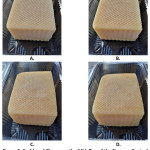 |
Figure 3: Kashkaval Cheese on the 14th Day of the Storage: Control (A); Edible Films of 1% CMC with 1% Propolis Ethanolic Extracts – T1 (B), T2 (C), and T3 (D) – the Absence of Fungal Growth and Visible Signs of Spoilage in all Samples. |
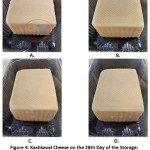 |
Figure 4: Kashkaval Cheese on the 28th Day of the Storage: Appearance of Fungal Growth in Control (A); Edible Films of 1% CMC with 1% Propolis Ethanolic Extracts – T1 (B), T2 (C), and T3 (D) – the Absence of Fungal Growth and Visible Signs of Spoilage. |
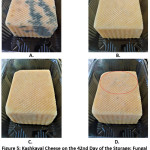 |
Figure 5: Kashkaval Cheese on the 42nd Day of the Storage: Fungal Growth in Control (A); Edible Films of 1% CMC with 1% Propolis Ethanolic Extracts – T1 (B), T2 (C) – Absence of Fungal Growth, and Visible Signs of Spoilage; the Appearance of Fungal Growth in the Sample with Edible Film T3 (D). |
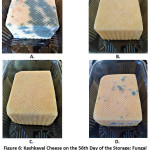 |
Figure 6: Kashkaval Cheese on the 56th Day of the Storage: Fungal Growth in Control (A); Edible Films of 1% CMC with 1% Propolis Ethanolic Extracts – T1 (B), T2 (C) – Absence of Fungal Growth, and Visible Signs of Spoilage; Fungal Growth in the Sample with Edible Film T3 (D). |
As seen in Table 4, the application of the edible films of 1% CMC with three types of 1% propolis ethanolic extracts on kashkaval cheese did not influence the initial fungal counts in samples T1, T2, and T3, and they remained equal to the control value of 30 cfu/g by the end of the first week of the refrigerated storage. After the 7th day, T1 and T2 edible films inhibited the fungal growth in kashkaval cheese (< 10 cfu/g), and until the end of the storage period, no visible signs of fungal spoilage were observed (Fig. 3 B, C; 4 B, C; 5 B, C and 6 B, C). However, a different trend in kashkaval cheese treated with T3 edible film was detected. In T3 sample the fungal counts gradually increased, but no visible signs of fungal spoilage were observed (Fig. 3 D and 4 D). The first visible signs of fungal spoilage in T3 appeared on the 42nd day (Fig. 5 D), which became pronounced on the 56th day of the storage period (Fig. 6 D). For comparison, the fungal counts in untreated cheese (control) also increased with the prolongation of the storage period, reaching values of 1.0×104 on the 56th day, but the first signs of fungal growth were observed on the 28th day of the storage (Fig. 3 A; 4 A; 5 A and 6 A). Thus, we can conclude that edible films with propolis extract T1 and T2 inhibited most effectively the fungal growth in kashkaval cheese and helped to improve the microbiological profile and storage life of the product.
Dairy products, especially hard cheese are highly susceptible to fungal growth, which may occur during the ripening, storage, and distribution, resulting in deterioration of sensory properties of the product, potential toxicity for the consumers, and economic losses for the manufacturers. Among the most common fungal genera responsible for cheese spoilage are Cladosporium, Penicillium, Phoma27, Aspergillus, Alternaria, Eurotium, Fusarium, and Mucor28, which develop as dark stains on the cheese surface. To avoid fungal spoilage, many cheese producers use different approaches such as higher salt concentrations, application of weak acids, antibiotics (natamycin), etc. However, some antibiotics possess a negative impact on human health, which could be overcome by the use of natural and safe antimicrobial substances such as propolis. Besides the antimicrobial effect, the application of propolis can improve the shelf-life of dairy products by increasing the antioxidant capacity, thus prevent lipid oxidation and associated aldehyde production.29
Aly and Elewa30 applied water propolis extracts (250, 500, and 1000 ppm) on the surface of Egyptian Ras cheese and evaluated the antifungal effect on Aspergillus versicolor and biosynthesis of sterigmatocystin during the stage of ripening. The authors stated that the higher concentration of propolis (1000 ppm) inhibited the fungal growth and toxin production during 3 months of ripening. Correa et al.,31 examined the microflora on the surface of Gorgonzola-type cheese and evaluated the antifungal and antibacterial effects of ethanol extract of propolis applied on the cheese. Besides the promising antimicrobial effect of propolis, the results from the sensory analysis showed that 5% extract did not alter the organoleptic characteristics of cheese, while addition of 10% extract led to a slight decrease in acceptance.
Еffects of Edible Films on The Organoleptic Properties of Kashkaval Cheese
The results from organoleptic analysis performed on the next day after the application of edible films demonstrated that T2 treatment and untreated sample (control) received higher scores from the tasters in comparison with T1 and T3 treatments. The application of 1% CMC edible film with 1% propolis ethanolic extract led to an increase in acceptance of T2 treatment regarding the following parameters – odor, texture, overall appearance, and color, compared to the control, T1 and T3 treatments. The control sample kept the highest scores and acceptance rate for the rest parameters – taste, aroma, and cutting surface (Fig. 7). Based on the results from organoleptic analysis, the four experiment groups can be arranged as follows: T2 (average score 8.35) > control (average score 8.32) > T3 (average score 7.94) > T1 (average score 7.87) from maximal 9 points.
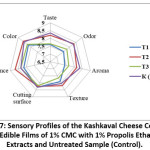 |
Figure 7: Sensory Profiles of the Kashkaval Cheese Covered with Edible Films of 1% CMC with 1% Propolis Ethanolic Extracts and Untreated Sample (Control). |
Conclusion
The results of the present study revealed that during refrigerated storage at 4°C for 56 days, T1 and T2 edible films inhibited the fungal growth on the kashkaval cheese surface, while T3 edible film only delayed this process. The application of three types of edible films did not affect the total number of lactic acid bacteria and yeasts counts in kashkaval cheese. The results from organoleptic analysis demonstrated that T2 treatment had the highest acceptance from the consumers, followed by the control, T3 and T1 treatments. Thus, the application of 1% CMC edible films enriched with three types of 1% propolis ethanolic extracts could be considered an effective mean for biopreservation by inhibiting and delaying the fungal growth in kashkaval cheese, thus improving the safety and storage life of the product.
Acknowledgment
The authors declare no conflict of interest.
References
- Sforcin J. M., Bankova V. Propolis: Is there a potential for the development of new drugs? J Ethnopharmacol. 2011; 133(2): 253–260.
CrossRef - Wagh V. D. Propolis: A Wonder Bees Product and Its Pharmacological Potentials. Adv Phar Sc. 2013; 1–11.
CrossRef - Daneshmand A., Sadeghi G., Karimi A., Vaziry A., Ibrahim, S. A. Evaluating complementary effects of ethanol extract of propolis with the probiotic on growth performance, immune response and serum metabolites in male broiler chickens. Livest Sci. 2015; 178: 195–201.
CrossRef - Bankova V., Popova M., Trusheva, B. New emerging fields of application of propolis. Maced J Chem Chem Eng. 2016; 35(1): 1–11.
CrossRef - Toreti V. C., Sato H. H., Pastore G. M., Park Y. K. Recent Progress of Propolis for Its Biological and Chemical Compositions and Its Botanical Origin. Evid-Bas Complement Altern Med. 2013; 1 –13.
CrossRef - Huang S., Zhan C.-P., Wang K., Li G., Hu F.-L. Recent Advances in the Chemical Composition of Propolis. 2014; 19(12): 19610–19632.
CrossRef - Pobiega K., Kraśniewska K., Gniewosz, M. Application of propolis in antimicrobial and antioxidative protection of food quality – A review. Trends Food Sci Tech. 2019; 83: 53–62.
CrossRef - Salomao K., Dantas A. P., Borba C. M., Campos L. C., Machado D. G., Aquino Neto F. R., Castro, S. L. Chemical composition and microbicidal activity of extracts from Brazilian and Bulgarian propolis. Lett Appl Microbiol. 2004; 38(2): 87–92.
CrossRef - Cauich-Kumul R., Segura Campos M. R. Bee Propolis: Properties, Chemical Composition, Applications, and Potential Health Effects. In: Bioactive Compounds. 2019; 227–243.
CrossRef - Tumbarski Y., Yanakieva V., Nikolova R., Mineva G., Deseva I., Mihaylova D., Ivanov I. Application of a bacteriocin isolated from Bacillus methylotrophicus BM47 as a biopreservative in raw cow’s milk. Indust Technol. 2018; 5(1): 20-25.
- Bulgarian State Standard BDS 14:2010. Bulgarian Kashkaval. Bulgarian Institute of Standardization, Sofia, Bulgaria.
- Kure C. F., Skaar I. The fungal problem in cheese industry. Curr Opin Food Sci. 2019; 29: 14-19.
CrossRef - Talevski, Srbinovska S., Santa D., Mateva N. Influence of packaging materials on Kashkaval quality. Mljekarstvo. 2017; 67(1): 25-32.
- Garnier L., Valence F., Mounier J. Diversity and Control of Spoilage Fungi in Dairy Products: An Update. 2017; 5(3): 42.
CrossRef - Bulgarian State Standard BDS 1111:1980. Milk and milk products – Determination of acidity. Bulgarian Institute of Standardization, Sofia, Bulgaria (in Bulgarian).
- Bulgarian State Standard BDS ISO 6611:2006. Milk and milk products – Enumeration of colony-forming units of yeasts and/or moulds – Colony-count technique at 25 degrees C. Bulgarian Institute of Standardization, Sofia, Bulgaria.
- Tzaneva D., Djivoderova M., Petkova N., Denev P., Hadzhikinov D., Stoyanova A. Rheological properties of the cosmetic gel including carboxymethyl chitosan. J Pharm Sci Res. 2017; 9(8): 1383–138
- Vajravelu K., Prasad K. V., Datti P. S., Raju B. T. Convective flow, heat and mass transfer of Ostwald-de Waele fluid over a vertical stretching sheet. J King Saud Uni Eng Sci. 2017; 29(1): 57–67.
CrossRef - Marinova M., Kalinova G., Grigorova E. Physicochemical parameters of Bulgarian yellow cheese from cow’s milk (kashkaval) during the standardized manufacturing. Bulg Chem Commun. 2016; 48: 424 – 427.
- Metwalli S. A. H. Extended shelf life of kareish cheese by natural preservatives. Egypt J Agric Res. 2011; 89(2): 639-649.
CrossRef - El-Deeb A. M., Omar S. A. Effect of Propolis Extract as a Natural Preservative on the Microbial Content of Kareish Cheese. J Food Dairy Sci. 2017; 8(7): 295–302.
CrossRef - Gammariello D., Di Giulio S., Conte A., Del Nobile M. A. Effects of Natural Compounds on Microbial Safety and Sensory Quality of Fior di Latte Cheese, a Typical Italian Cheese. J Dairy Sci. 2008; 91(11): 4138–4146.
CrossRef - Saleh K. A. H., Khalil O. S. F. Extension Shelf Life of Domiati Cheese Made by Using Some of Natural Preservatives. Assiut J Agric Sci. 2019; 50(1): 1-14.
CrossRef - Dimitrov, Simov Z., Dimitrov Z., Ospanov A. Improving of the microbiological and proteolytic profile of kashkaval cheese by modification in heat treatments of cow’s milk and cheddared curd. J Microbiol Biotech Food Sci. 2015; 4(6): 546-549.
CrossRef - Bojana D., Nebojša M., Dragoljub C., Dragiša S. Lactic acid bacteria microbiota of “Pirot`s Kashkaval”. Ital J Food Sci. 2020; 32: 743-754.
- Kavas G., Kinik O., Uysal H., Kilic S., Celikel N., Akbulut N. Characterisation of Yeasts Isolated from Artisanal Turkish Dairy Products. Int J Dairy Sci. 2010; 5(3): 185-191.
CrossRef - Basilico J. C., deBasilico M. Z., Chiericatti C., Vinderola C. G. Characterization and control of thread mould in cheese. Lett Appl Microbiol. 2001; 32(6): 419–423.
CrossRef - Taniwaki M., Hocking A., Pitt J., Fleet G. Growth of fungi and mycotoxin production on cheese under modified atmospheres. Int J Food Microbiol. 2001;68(1-2): 125–133.
CrossRef - Cottica S. M., Sabik H., Bélanger D., Giroux H. J., Visentainer J. V., Britten M. Use of propolis extracts as antioxidant in dairy beverages enriched with conjugated linoleic acid. Eur Food Res Technol. 2015; 241(4): 543–551.
CrossRef - Aly S. A., Elewa N. A. The effect of Egyptian honeybee propolis on the growth of Aspergillus versicolor and sterigmatocystin biosynthesis in Ras cheese. J Dairy Res. 2007; 74(1): 74-78.
CrossRef - Correa F. T., de Souza A. C., de Souza Júnior E. A., Isidoro S. R., Piccoli R. H., Dias D. R., de Abreu L. R. Effect of Brazilian green propolis on microorganism contaminants of surface of Gorgonzola-type cheese. J Food Sci Tech. 2019; 56: 1978–1987.
CrossRef

This work is licensed under a Creative Commons Attribution 4.0 International License.


